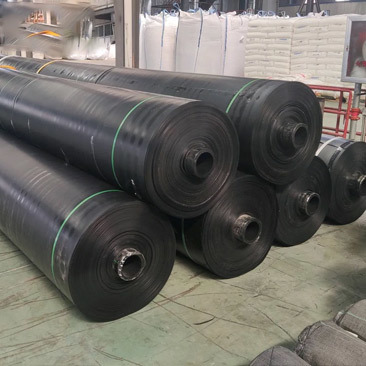Geomembrane Applications: A Comprehensive Guide for Builders
Release time:
2025-10-06
Geomembrane Applications: A Comprehensive Guide for Builders Table of Contents 1. Introduction to Geomembranes 2. What Are Geomembranes? 3. Types of Geomembranes 4. Advantages of Using Geomembranes in Construction 5. Key Applications of Geomembranes 6. Best Practices for Installing Geomembranes 7. Case Studies on Geomembrane Applications 8. Frequently Asked Que
Geomembrane Applications: A Comprehensive Guide for Builders
Table of Contents
- 1. Introduction to Geomembranes
- 2. What Are Geomembranes?
- 3. Types of Geomembranes
- 4. Advantages of Using Geomembranes in Construction
- 5. Key Applications of Geomembranes
- 6. Best Practices for Installing Geomembranes
- 7. Case Studies on Geomembrane Applications
- 8. Frequently Asked Questions
- 9. Conclusion
1. Introduction to Geomembranes
Geomembranes have emerged as a crucial component in modern construction and landscaping. As builders face increasing challenges related to environmental regulations and resource management, geomembranes provide effective solutions. This guide outlines the various applications of geomembranes, primarily focusing on their benefits, types, and installation practices.
2. What Are Geomembranes?
Geomembranes are synthetic membranes used to control fluid migration in a variety of applications. They are typically composed of materials such as high-density polyethylene (HDPE), linear low-density polyethylene (LLDPE), polyvinyl chloride (PVC), or polypropylene. These materials offer excellent durability, flexibility, and resistance to various environmental factors, making them ideal for construction projects.
2.1 Key Features of Geomembranes
Geomembranes possess several key features that make them indispensable in construction projects:
- **Impermeability**: Geomembranes are designed to prevent the passage of liquids, making them ideal for applications that require fluid containment.
- **Chemical Resistance**: Many geomembranes are resistant to chemicals, making them suitable for use in landfills and wastewater treatment facilities.
- **Durability**: Geomembranes are engineered to withstand harsh environmental conditions, including UV exposure and temperature extremes.
- **Flexibility**: The flexibility of geomembranes allows for easy installation on uneven surfaces, ensuring a tight seal.
3. Types of Geomembranes
Understanding the different types of geomembranes is crucial for builders. Each type has unique properties and applications.
3.1 High-Density Polyethylene (HDPE) Geomembranes
HDPE geomembranes are known for their high tensile strength and resistance to chemicals and UV degradation. They are widely used in landfill liners and pond liners.
3.2 Linear Low-Density Polyethylene (LLDPE) Geomembranes
LLDPE geomembranes offer excellent flexibility and elongation properties, making them ideal for applications where movement is expected, such as in landfill covers.
3.3 Polyvinyl Chloride (PVC) Geomembranes
PVC geomembranes are lightweight and easy to install. They are commonly used in irrigation and aquaculture applications.
3.4 Polypropylene Geomembranes
Polypropylene geomembranes are known for their high chemical resistance, making them suitable for industrial applications.
4. Advantages of Using Geomembranes in Construction
Incorporating geomembranes into construction projects offers several advantages.
4.1 Environmental Protection
Geomembranes play a vital role in preventing soil and groundwater contamination by containing hazardous materials in landfills.
4.2 Cost-Effectiveness
The durability and long lifespan of geomembranes reduce maintenance costs over time, leading to significant savings for project managers.
4.3 Versatility
Geomembranes can be used in a wide range of applications, including containment systems, erosion control, and water management.
4.4 Sustainable Practices
Using geomembranes can enhance sustainability efforts by minimizing waste and conserving water resources through effective containment strategies.
5. Key Applications of Geomembranes
Geomembranes find use in various sectors, including construction, agriculture, and waste management.
5.1 Landfill Liners
One of the most common applications, landfill liners utilize geomembranes to prevent leachate from contaminating groundwater.
5.2 Water Reservoirs
Geomembranes are often employed in the construction of water reservoirs to minimize evaporation and ensure water quality.
5.3 Mining Operations
In mining, geomembranes help manage tailings and waste by preventing contamination of surrounding areas.
5.4 Agricultural Applications
Geomembranes are used in agricultural systems for irrigation and aquaculture, ensuring efficient water retention and management.
5.4.1 Irrigation Systems
In irrigation, geomembranes enhance water conservation by reducing seepage and evaporation rates.
5.4.2 Aquaculture Ponds
Geomembranes create a controlled environment for aquaculture, ensuring water quality and preventing the escape of aquatic species.
5.5 Erosion Control
Geomembranes are effective in controlling erosion on slopes and embankments, providing stability and preventing soil loss.
6. Best Practices for Installing Geomembranes
Proper installation of geomembranes is crucial to ensure their effectiveness. Here are some best practices.
6.1 Site Preparation
Begin with thorough site preparation, including clearing debris and leveling the surface to prevent punctures and tears.
6.2 Material Handling
Transport and handle geomembranes with care to avoid damage. Use protective equipment when moving heavy rolls.
6.3 Seam Welding Techniques
Use appropriate seam welding techniques to ensure airtight seals. Overlapping seams should be at least 12 inches to prevent leakage.
6.4 Regular Inspections
Conduct regular inspections of installed geomembranes for signs of wear or damage to maintain optimal performance.
7. Case Studies on Geomembrane Applications
Examining real-world applications can provide valuable insights into the effectiveness of geomembranes.
7.1 Case Study: XYZ Landfill
At XYZ Landfill, the installation of HDPE geomembranes led to a significant reduction in leachate levels, ensuring compliance with environmental regulations.
7.2 Case Study: Agricultural Water Conservation Project
In a recent agricultural project, the use of LLDPE geomembranes in irrigation systems resulted in a 30% reduction in water usage while increasing crop yields.
7.3 Case Study: Mining Tailings Management
The use of geomembranes in the management of mining tailings at ABC Mine prevented contamination of local water sources and demonstrated the effectiveness of geomembranes in hazardous environments.
8. Frequently Asked Questions
8.1 What are the main benefits of using geomembranes?
Geomembranes provide environmental protection, cost-effectiveness, versatility, and promote sustainable practices in construction.
8.2 How long do geomembranes last?
With proper installation and maintenance, geomembranes can last for several decades, depending on the material and environmental conditions.
8.3 Can geomembranes be repaired?
Yes, geomembranes can be repaired using specific techniques such as patching and welding to maintain their effectiveness.
8.4 Are geomembranes environmentally friendly?
While geomembranes are synthetic materials, their use often leads to improved environmental outcomes by preventing contamination and conserving resources.
8.5 What is the cost of geomembranes?
The cost of geomembranes varies based on material type, thickness, and application. It’s essential to consider long-term savings in maintenance and environmental compliance.
9. Conclusion
In conclusion, geomembranes are an invaluable resource for builders looking to enhance sustainability and efficiency in construction projects. Their wide range of applications, combined with their durability and environmental benefits, positions geomembranes as a critical element in modern construction practices. By understanding their types, advantages, and best practices, builders can effectively integrate geomembranes into their projects, ensuring long-term success and compliance with environmental regulations. As the construction industry continues to evolve, the role of geomembranes will undoubtedly become more significant, paving the way for innovative solutions in water management, waste containment, and environmental protection.
Previous Page






